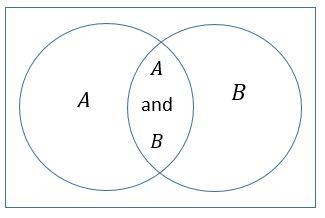Difference between revisions of "Some Probability Formulas"
Ciskowskid (talk | contribs) (Created page with "== Some useful probability formulas == '''The Addition Rule''' Consider 2 events, ''A'' and ''B''. To find the probability that either ''A'' or ''B'' (or both) will occur, w...") |
Ciskowskid (talk | contribs) (→Some useful probability formulas) |
||
| (4 intermediate revisions by the same user not shown) | |||
| Line 6: | Line 6: | ||
[[File:Addition_Rule_Formula.JPG]] | [[File:Addition_Rule_Formula.JPG]] | ||
| + | |||
| + | We subtract the probability of both ''A'' and ''B'' occurring, as to not "double count" them. This can seen better by looking at the following Venn Diagram: | ||
| + | |||
| + | [[File:A_and_B_Venn_Diagram.JPG]] | ||
| + | |||
| + | '''Conditional Probability''' | ||
| + | |||
| + | Sometimes we would like to know the probability of an event ''B'' occurring, given that another event ''A'' has already occurred. This in called conditional probability and we use the notation: | ||
| + | |||
| + | [[File:Condition_Probability_Notation.JPG]] | ||
| + | |||
| + | This is read as "The probability of B given A," and can be calculated as follows: | ||
| + | |||
| + | [[File:Conditional_Probability_Formula.JPG]] | ||
| + | |||
| + | ''contributed by David Ciskowski'' | ||
Latest revision as of 11:40, 11 May 2022
Some useful probability formulas
The Addition Rule
Consider 2 events, A and B. To find the probability that either A or B (or both) will occur, we can use the following formula, called the addition rule:
We subtract the probability of both A and B occurring, as to not "double count" them. This can seen better by looking at the following Venn Diagram:
Conditional Probability
Sometimes we would like to know the probability of an event B occurring, given that another event A has already occurred. This in called conditional probability and we use the notation:
This is read as "The probability of B given A," and can be calculated as follows:
contributed by David Ciskowski



